Bertrand Goldberg in Tower Town is a three-part set of articles, and the first in a series of several Forgotten Chicago features highlighting the Chicago-based architect’s one-time residence in the 1930s, and lesser-known built and proposed projects in the Chicago area. This article examines Goldberg’s former residence on the site of the former Senator Charles Farwell home. Future Forgotten Chicago articles will also examine built Goldberg projects that have been heavily altered, demolished, or abandoned, as well as the highly concentrated area of constructed and proposed Goldberg projects on and around Chicago’s Rush Street.
Although not designed by the architect, the location of Goldberg’s one-time residence near several of his later commissions has a long and colorful history crucial to the development of the Chicago area in general, and Michigan Avenue in particular. In Goldberg’s oral history, recorded in 1992, Goldberg recalls where he lived in Chicago after returning to the U.S. from Germany in 1933 after studying at the Bauhaus and working in Mies van der Rohe’s office in Berlin.

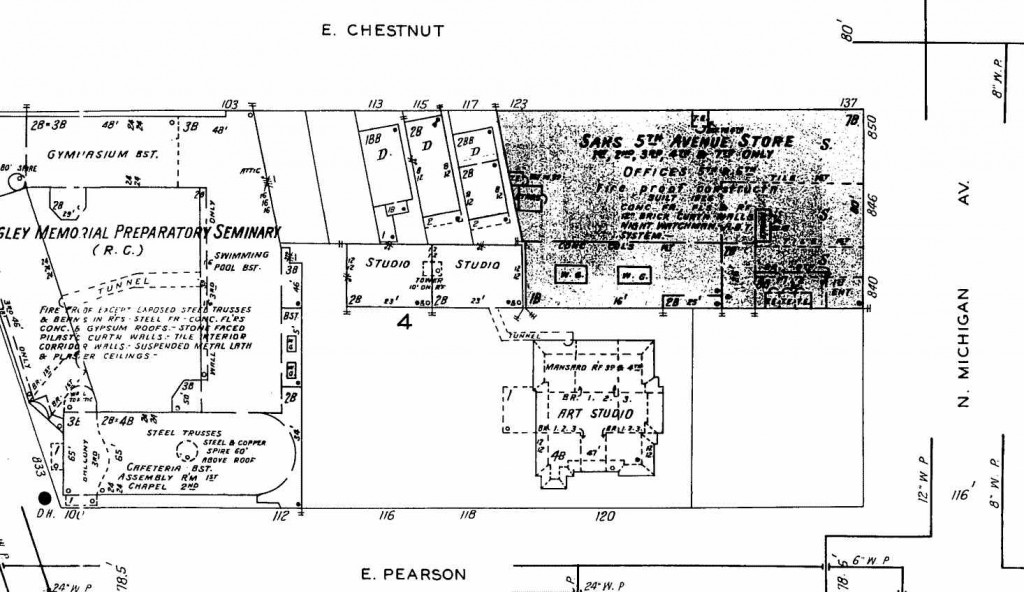 Left: Chicago Transit Authority. Right: Sanborn.
Left: Chicago Transit Authority. Right: Sanborn.
Goldberg recalls, “In those years I lived on Michigan Avenue and Pearson Street. There was a very big old stable and garage there at the northwest corner of Michigan and Pearson, adjacent to Tower Court. It was a commune, really, as we have some to identify them, but I think about forty or fifty people lived in that building, very inexpensively, and I shared a studio with Edward Millman.”1 Tower Court was the former name of the one-block street just to the west of the Water Tower between Chicago Avenue and Pearson Street. By the 1950s, Tower Court was commonly referred to as North Michigan Avenue.2
Known as Chicago’s Bohemian district from the 1920s to the 1950s, the name Tower Town was applied to an area north of the Chicago River centered near the historic Water Tower. Perhaps the most concise description of this area is from the 1950 book Chicago Confidential. This book describes Tower Town as an “area surrounding the historic Water Tower at Michigan and Chicago Avenue (800 N.). Generally embraces the pleasanter part of the near North Side, with shops, fine restaurants, rich bohemians and expensive broads.”3
The large residence at 120 East Pearson was designed by Treat & Foltz in the 1880s for U.S. senator Charles Farwell; just to the east, at the corner of Pearson and Michigan Avenue, another home was built for his brother, merchant John V. Farwell.4 The John Farwell home is no longer extant in the pictured 1935 fire insurance map, and its demolition date is not known. In a 1946 Chicago Tribune article on the impending demolition of the Charles Farwell house for construction of a new Bonwit Teller store, it was written that while the John Farwell home had been “razed long ago”,5 the “red front” Charles Farwell home was still standing. Additional information on the Charles Farwell home, including its date of its conversion from a single-family home to commercial uses and rental housing detailed below, is not known.
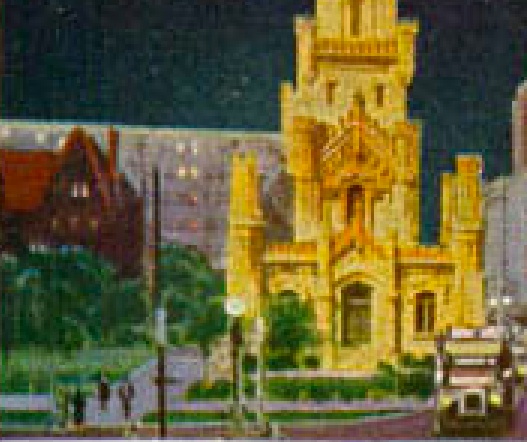
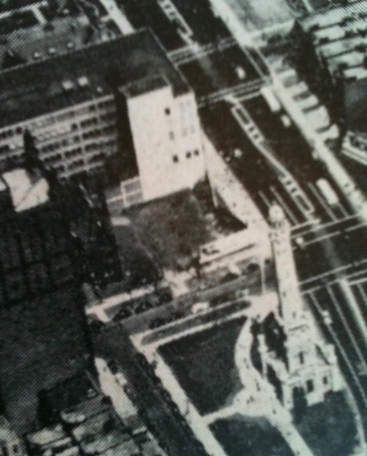
Left: Chuckman Collection Right: Realty & Building.
In the 1930s, the Farwell mansion went through many incarnations. According to the pictured fire insurance map, it was by 1935 an “art studio” at 120 East Pearson connected by a tunnel to a building set back from Pearson Street at 118 East Pearson. The building at 118 East Pearson shares a common wall with 116 East Pearson; it is not clear in which of the (presumably) two rear buildings Goldberg lived, or if any of these three buildings shared a common owner in the 1930s. Since it may have been unlikely for a “commune” to advertise for tenants in a publication such as the Chicago Tribune, it may not be surprising that classified ads for that newspaper from April 1, 1933 to December 31, 1937 do not contain any listings for rooms, apartments or studios for rent at the former stables at 116 or 118 East Pearson Street during Goldberg’s time living there.6

Chicago Tribune classified ad, April 11 and 14, 1933.
However, on both April 11 and April 14, 1933, the ad above appeared in the Tribune for “PEARSON, E., 120 – – Large Double Rms., private bath: gentlemen only. Del. 0903”7
 Chicago Tribune classified ad, May 27, 1934.
Chicago Tribune classified ad, May 27, 1934.
On May 27, 1934, another ad appeared in the Tribune stating, “120 E. PEARSON – – STUDIO APTS.: OLD mansion opened: good for home or business.”8 As mentioned previously, it is not known if 116, 118 and 120 East Pearson had the same owner in the 1930s, or if they did have the same owner, if rentals for all three buildings were advertising using one classified ad. Besides the two classified ads appearing, there were no further Tribune classified listings found for studios, rental rooms or apartments at 120 East Pearson from April 1, 1933 to December 31, 1937.9
Referencing Goldberg’s oral history, it is not clear during which years he lived on East Pearson; Goldberg says he left Berlin soon after the closure of the Bauhaus by the Nazi government on April 11, 1933.10 After Goldberg left Berlin, he spent less than one week in Paris,11 visited architect Philip Johnson in New York City,12 and eventually returned to Chicago, where he did tutorial work at the Armour Institute, and worked in the office of George Fred Keck.13 It is also not known where Goldberg moved after living at Michigan and Pearson; his first paid commission was for the 1935 Harriet Higginson house in Wood Dale, Illinois, for which he was paid a commission of $100.14
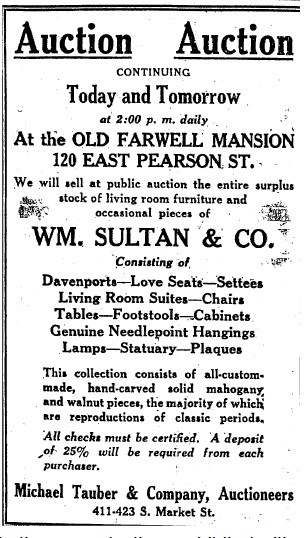
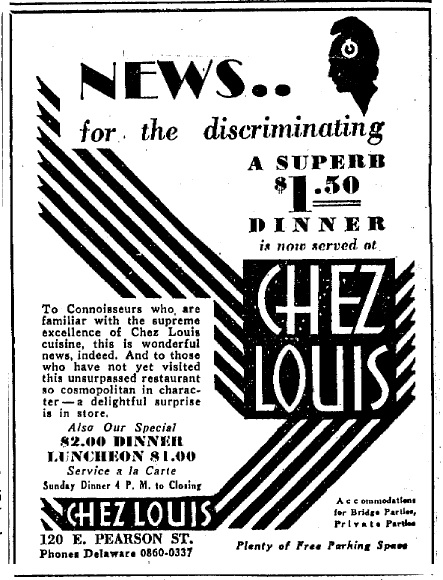
Left: Chicago Tribune, December 1930. Right: Chicago Tribune, March 1932.
By 1930, the Farwell mansion was home to the furniture store Wm. Sultan & Co.,15 and was later home of restaurant Chez Louis, which advertised in the Chicago Tribune in November 1931 and March 1932.16 The mention of “Plenty of Free Parking Spaces” suggests that land on one or both sides of 120 East Pearson, including the former site of the now-demolished John V. Farwell home at the corner of Pearson and Michigan, had been a surface parking lot prior to 1935.

Chicago Daily News
Chez Louis may not have lasted long, however, in the old Farwell mansion. On Friday the 13th of January 1933, a restaurant called Louisiane at 120 East Pearson hosted an organization called the “Anti-Superstition Society” which was formed to confront “Old Man Misfortune” during the Great Depression.17 With the exception of Sultan & Co., rental housing, restaurants Chez Louis and Louisiane, no other mentions of 116, 118 and 120 East Pearson have been found in the Chicago Tribune archives between 1930 and 1939.18
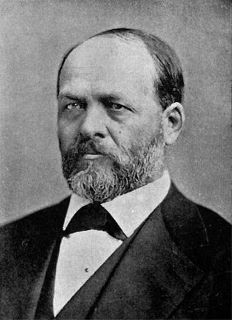 GoldenMap GoldenMap
Senator Charles Farwell
|
An early and prominent business leader, Charles Farwell (1823-1903) was called “one of the principal builders in the business district”19 in an obituary upon his death. Farwell was also credited in the completion of Chicago’s first streetcar tunnel, at Washington Street under the Chicago River.20 A Republican, Farwell was also a key political figure in Illinois in the 1800s. Elected twice as Cook County Clerk, he then defeated former mayor “Long” John Wentworth for the U.S. House of Representatives in 1870 by 5,300 votes.21 Farwell would serve four terms in the House of Representatives, and following the death of Senator John Logan in 1887 Farwell completed the remaining four years of Logan’s term.
In Farwell’s first year in the U.S. Senate, some 32 years before it would eventually pass the legislative body, he voted in favor of introducing a women’s suffrage amendment to the U.S. Constitution.22 The Tribune, however, was highly skeptical of women obtaining rights such voting and holding public office.23 In an 1887 editorial, the newspaper declared, “adopting female suffrage looks a little premature to say the very least.”24 Following the end of his term, Farwell did not run for reelection, and returned to Chicago in 1891.
Farwell’s list of other accomplishments in the Chicago area is long. He has been credited with founding the town of Lake Forest, offering early financial support for what is now Lake Forest College, selecting the location of Fort Sheridan directly south of Lake Forest, and securing Chicago’s selection over New York, St. Louis and Washington as the location of the 1893 World’s Columbian Exhibition.25
Farwell’s influence was not limited to Illinois. He was a key player awarding Louisiana’s electoral votes to Republican Rutherford Hayes following the controversial 1876 presidential election where Democrat Samuel Tilden had received a majority of popular votes, with electoral votes in three southern states was in dispute.26 Perhaps most notably, Farwell, along with his brother John and other investors built the current Texas state capitol building in Austin in the 1880s in exchange for 3,000,000 acres of ranch land in the Texas panhandle.27
The Great Depression and World War II may have delayed the demolition of the Charles Farwell home for a multi-level retail store, but this prominent homes facing the Water Tower would still be razed less than 65 years after its completion. Part two of this series will explore the demolition of the Charles Farwell home, and the four primary tenants to occupy one of Michigan Avenue’s highest-profile retail locations since 1949.
Current Exhibitions (as of this writing) on the Work of Bertrand Goldberg:
• The Art Institute of Chicago has curated the first major retrospective on Goldberg’s career entitled Bertrand Goldberg: Architecture of Invention through January 15, 2012; more information at http://www.artic.edu/aic/collections/exhibitions/Goldberg/index.
• The Ryerson Library at the Art Institute is exhibiting ARCHITECTURE FOR URBANISM: Selections from the Bertrand Goldberg Archive until January 2, 2012; more information is at http://www.artic.edu/aic/libraries/about/news.html#exhibit.
• The Arts Club of Chicago is exhibiting Bertrand Goldberg: Reflections through February 8, 2012; more information at http://www.artsclubchicago.org/exhibitions/goldberg-bertrand/gallery.html.
1. INTERVIEWED BY BETTY J. BLUM. ORAL HISTORY OF BERTRAND GOLDBERG, pg. 78. Chicago Architects Oral History Project, Ernest R. Graham Study Center for Architectural Drawings, Department of Architecture, The Art Institute of Chicago.
2. JAMES M GAVIN. “Plan 13 Floor Hotel on Michigan.” Chicago Daily Tribune (1923-1963); Sep 13, 1959; Retx1 from ProQuest Historical Newspapers Chicago Tribune (1849 – 1987) pg. A9 (accessed October 11, 2011).
3. JACK LAIT and LEE MORTIMER; Chicago Confidential, pg. 291. New York: Crown Publishers, 1950.
4. “BONWIT TELLER TO BUILD STORE ON MICHIGAN AV.”, Chicago Daily Tribune (1923-1963); Nov 30, 1946; ProQuest Historical Newspapers Chicago Tribune (1849 – 1987) pg. 6 (accessed October 11, 2011).
5. Ibid.
6. Chicago Daily Tribune (1923-1963); ProQuest Historical Newspapers Chicago Tribune (1849 – 1987), archives for April 1, 1933 through December 31, 1937; (searched September 26, 2011).
7. “Classified Ad 3 — No Title”, Chicago Daily Tribune (1923-1963); Apr 11, 1933; pg. 29, and Classified Ad 3 — No Title, Chicago Daily Tribune (1923-1963); Apr 14, 1933; pg., 25; ProQuest Historical Newspapers Chicago Tribune (1849 – 1987) (accessed September 30, 2011).
8. “Classified Ad 6 — No Title”, Chicago Daily Tribune (1923-1963); May 27, 1934; ProQuest Historical Newspapers Chicago Tribune (1849 – 1987) pg. C5 (accessed September 30, 2011).
9. Chicago Daily Tribune (1923-1963); ProQuest Historical Newspapers archives from April 1, 1933 through December 31, 1937 (accessed September 26, 2011).
10. ORAL HISTORY OF BERTRAND GOLDBERG, pg. 34).
11. Ibid, pg. 37
12. Ibid, pg. 52
13. Ibid, pg. 52
14. Ibid, pg. 80
15. “Display Ad 9 — No Title”, Chicago Daily Tribune (1923-1963); Dec 14, 1930; ProQuest Historical Newspapers Chicago Tribune (1849 – 1987) pg. 10 (accessed September 19, 2011).
16. “Display Ad 13 — No Title”, Chicago Daily Tribune (1923-1963); Nov 7, 1931; pg. 15 and “Display Ad 42 — No Title”; Mar 6, 1932; ProQuest Historical Newspapers Chicago Tribune (1849 – 1987) pg. F2 (accessed September 19, 2011).
17. RUTH DE YOUNG. “This Is Friday, the 13th, but 13 Defy Ill Fate”, Chicago Daily Tribune (1923-1963); Jan 13, 1933; ProQuest Historical Newspapers Chicago Tribune (1849 – 1987) pg. 15 (accessed October 6, 2011).
18. Chicago Daily Tribune (1923-1963); ProQuest Historical Newspapers Chicago Tribune (1849 – 1987), archives for January 1, 1930 through December 31, 1939 (searched September 26, 2011).
19. “CHARLES B. FARWELL DIES”, Chicago Daily Tribune (1872-1922); Sep 24, 1903; ProQuest Historical Newspapers Chicago Tribune (1849 – 1987) pg. 4 (accessed September 19, 2011).
20. Ibid.
21. Ibid.
22. “SENATOR FARWELL ON WOMAN SUFFRAGE”, Chicago Daily Tribune (1872-1922); Mar 8, 1887; ProQuest Historical Newspapers Chicago Tribune (1849 – 1987) pg. 4 (accessed October 6, 2011).
23. Ibid.
24. Ibid.
25. “FARWELL, CHARLES BENJAMIN (1823-1903)”, Lake Forest College Library Archives and Special Collections, http://archon.lakeforest.edu/?p=creators/creator&id=122
26. Ibid.
27. Ibid.
- Bertrand Goldberg in Tower Town Part 2: Postwar Development of Michigan & Pearson
- Bertrand Goldberg in Tower Town Part 3: Bertrand Goldberg’s Michigan Avenue Project
- Old Addresses
- Media & Press
- Disused Fire Stations Part 1 – 19th Century



